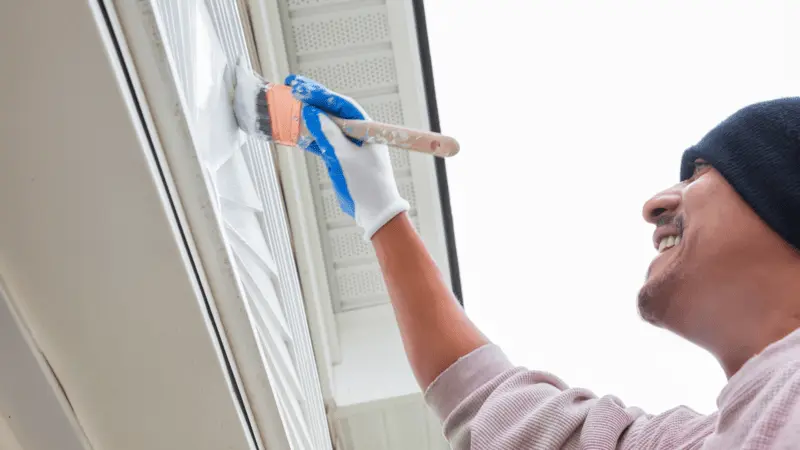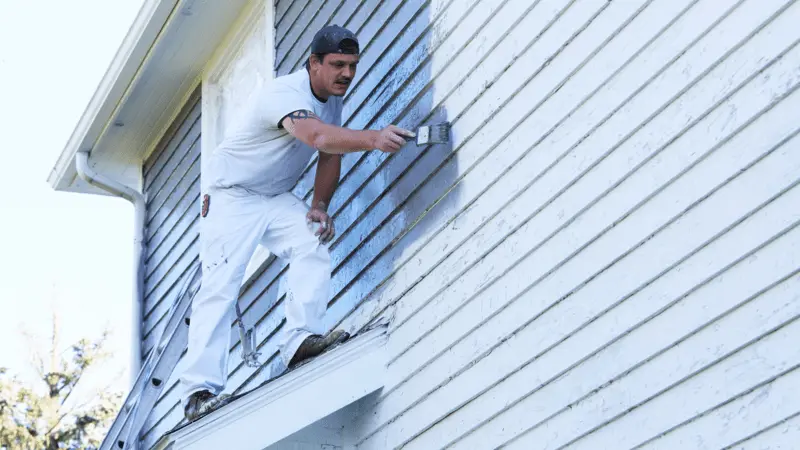The quest for a freshly painted exterior, whether it’s your home or a cherished project, often comes with the pressing question: how long does exterior paint need to dry before rain? The answer lies in the type of paint you choose. While oil-based paint insists on a patient 24-hour wait, its acrylic latex counterpart promises resilience after just 2 hours.
Let’s unveil the art of timing your exterior paint project with precision, ensuring that rain won’t wash away your vision for a stunning and enduring finish.
How Long Does Exterior Paint Need To Dry Before Rain

Different types of exterior paint, particularly oil paint and acrylic latex paint, have varying drying times.
Oil Paint: Allow 24 Hours Before Rain Exposure
Oil-based exterior paint is robust but slow to dry. To protect your freshly painted exterior from rain damage, it’s crucial to allow at least 24 hours for the oil paint to cure before potential exposure to rain. Planning painting projects on rain-free days is advisable when using oil-based paint.
Acrylic Latex Paint: Rain-Resistant After Two Hours
Acrylic latex paint is a popular choice due to its quicker drying time. After two hours of application, the paint should be sufficiently dry to resist light rain. However, waiting longer before exposing it to heavy rain is recommended for a durable, blemish-free finish.
Oil Vs Latex Paint: Response On Drying
| Oil Paint | Acrylic Latex Paint | |
| Drying Time | At least 24 hours | Rain-resistant after 2 hours |
| Weather Resistance | Slower drying, more susceptible to rain | Quick drying, less affected by light rain |
| Recommended Conditions | Dry weather, moderate temperature | Can withstand light rain and higher humidity |
| Best Application | Ideal for less humid and rainy climates | Suitable for various climates and quick projects |
| Curing Time | Takes longer to cure fully | Cures relatively faster |
Is There a Special Exterior Rain Paint?
Yes, there are special exterior paints designed to withstand rainy conditions and provide long-lasting protection for various surfaces. Water-based paints are ideal for outdoor projects and rainy days. They are more resistant to cracking, peeling, and discoloration compared to oil-based alkyd paints because they do not retain moisture underneath them.
For optimal durability, choose a latex paint with an acrylic binder. This type of paint, compared to those made with a vinyl-acrylic binder, stands up better to frequent, heavy rain and other elements. Water-based paints also expand and contract with your home’s siding, minimizing cracking, a property not found in oil-based paint, which takes days to cure entirely.
Both water-based and oil-based primers can be used with water-based paint. However, it’s essential not to use an oil-based paint with a water-based primer. Additionally, outdoor painting should never be attempted if rain is expected, as it can wash away drying paint, leaving streaks and an uneven finish.
Impact of Weather Conditions on Exterior Paint Drying Time

The weather conditions play a critical role in determining the drying time of exterior paint. Various weather elements, such as temperature, humidity, wind, and precipitation, can significantly influence how long it takes for paint to dry and cure properly.
Temperature
Higher temperatures generally expedite the drying process by evaporating the moisture in the paint more quickly. Conversely, lower temperatures slow down the drying time. Optimal drying often occurs in moderate temperatures, typically between 50 to 85 degrees Fahrenheit (10 to 30 degrees Celsius).
Humidity
Humidity levels affect the rate at which moisture evaporates from the paint. High humidity can prolong drying time as the air is already saturated with moisture, inhibiting the paint from releasing its moisture. Low humidity facilitates faster drying.
Wind
Wind aids in speeding up the drying process by enhancing evaporation. However, excessive wind can cause the paint to dry too quickly, potentially leading to uneven drying, cracking, or other imperfections.
Precipitation
Rain is a significant concern during exterior painting. It can ruin freshly painted surfaces, causing streaks, blotches, or wash-offs. Hence, it’s crucial to plan painting projects on days when rain is not expected within the paint’s curing time.
Sunlight
Direct sunlight can cause the paint to dry too quickly, with significantly darker colors, potentially leading to visible lap marks or brush strokes. It’s advisable to paint in shaded areas or follow the sun to avoid direct exposure during application.
Altitude
High-altitude locations with lower air pressure and thinner air may affect drying times. Paint may dry faster due to the thinner air, but adjustments might be needed to accommodate different conditions.
When It Rains Before The Paint Is Dry, What To Do Then?

When rain occurs before the paint is fully dry, it can lead to various issues like streaks, wash-offs, and an uneven finish. If you’re caught in this situation, here are steps to mitigate the damage and potentially salvage the paint job:
- Assess the Damage: Wait for the rain to stop and inspect the painted surface to determine the extent of the damage. Look for streaks, runs, or any visible imperfections.
- Allow Drying Time: If the rain was light and didn’t wash away the paint, allow the painted surface to dry thoroughly once the rain stops. Give it ample time to cure and evaluate the results.
- Sand and Repaint Affected Areas: If the rain caused visible damage, lightly sand the affected areas once they’re dry. Repaint those areas, ensuring you blend the new paint with the existing coat for a seamless finish.
- Consult a Professional: If the damage is extensive or if you’re unsure about how to proceed, consider consulting a professional painting agency like InexMax. They can provide advice on whether to touch up or redo the entire surface.
- Prevent Future Rain Damage: If possible, cover the painted surface with a tarp or plastic sheet if rain is expected again. This extra protection can prevent further damage until the paint is fully cured.
- Learn for Future Projects: Use this experience to plan future projects more effectively, considering weather forecasts and allowing sufficient time for paint to dry without potential weather interruptions.
How Long Should I Wait After Rain To Repaint?

After rain, it’s important to wait for at least 24-48 hours of consistent dry weather before repainting. The surface needs to be completely dry to ensure proper adhesion and a smooth finish. High humidity or cold temperatures can extend the drying time. Checking the manufacturer’s recommendations for the specific paint you’re using is advisable, as some paints may have different drying requirements. Always prioritize a dry forecast and suitable weather conditions for successful repainting.
Can You Paint When It’s Raining?
Painting while it’s raining is not recommended. Rain can cause the paint to run, streak, or wash off, ruining the finish. Additionally, rain introduces moisture into the air and onto the surface being painted, affecting the paint’s ability to adhere correctly and cure. It’s crucial to wait for dry weather before starting a painting project to ensure a successful and long-lasting paint job. Always check the weather forecast and choose a time when rain is not expected within the drying and curing period recommended by the paint manufacturer.
When Should You Schedule Your First Exterior Paint Job?
The best time to schedule your first exterior paint job largely depends on the climate in your region and the availability of professional painters. Ideal periods for consulting with an exterior house painter are during the months of November through February, as this is typically an off-season for many painters due to decreased workload. During this time, painters often have more availability and can dedicate more time to discussing your project and planning accordingly.
On the contrary, the summer months tend to be a busy season for painters, making it challenging to get their immediate attention. Many customers need help getting contractors to return their calls promptly during this busy period. To avoid this, it’s advisable to have a direct and private conversation with your painter during the off-peak months to ensure they can accommodate your project when you need it.
Tips For Exterior Painting In Rainy & Cold Weather

Painting exteriors during rainy and cold weather can present challenges, but with the right approach, you can still achieve a successful paint job. Here are seven tips for exterior painting in such conditions:
Check Weather Forecast
Monitor the weather forecast and select a period with the slightest chance of rain or extreme cold. Plan the painting project during a dry spell to ensure the paint has sufficient time to dry and cure.
Use Weather-Resistant Paint
Opt for high-quality, weather-resistant exterior paint that can withstand moisture and cold temperatures. Acrylic latex paints are a good choice as they dry faster and adhere well, even in varying weather conditions.
Avoid Painting in Direct Rain
Never paint when it’s actively raining or when rain is imminent. Rain can ruin the freshly applied paint and lead to streaking or uneven finishes.
Optimal Temperature Range
Aim to paint when the temperature is within the recommended range specified by the paint manufacturer. Cold weather can slow down the drying process, so choose a time when temperatures are at least above 50°F (10°C).
Proper Surface Preparation
Ensure the surface is clean, dry, and free of any moisture before painting. Properly scrape, sand, and prime the surface to provide a good base for the paint to adhere to.
Apply Thin Coats
Apply thinner coats of paint in cold weather to help with quicker drying. Avoid heavy application, as it may not dry or cure properly, leading to surface imperfections.
Allow Sufficient Drying Time
Be patient and allow each coat of paint to dry thoroughly before applying the next one. Cold weather may extend the drying time, so follow the manufacturer’s recommendations for the specific paint being used.
Frequently Asked Questions
1. Can I Apply A Rain-Resistant Coating To Speed Up The Drying Process?
While rain-resistant coatings may offer some protection, they won’t accelerate the drying time of the paint. It’s best to allow the paint to dry naturally and adhere to the manufacturer’s recommended drying time.
2. Can I Use Fans Or Heaters To Speed Up The Drying Process Before Rain?
Fans and heaters can help to some extent, especially in cold or humid conditions, by improving air circulation and reducing humidity. However, they won’t drastically speed up the drying process, and it’s essential to follow standard drying time guidelines.
3. What If The Rain Starts Shortly After I’ve Finished Painting?
If rain starts shortly after painting and the paint is still wet, it’s likely to be washed away or develop streaks. If it’s a light drizzle, try to cover the area with a tarp to protect it. If rain is heavy, you may need to repaint the affected area once the surface is dry.
4. Can I Check If The Paint Is Dry By Touching It?
It’s advisable not to touch the paint to check if it’s dry, as this can leave fingerprints or marks. Instead, follow the recommended drying time mentioned by the paint manufacturer for the specific product you’ve used.
5. Can I Apply A Sealant To Protect The Paint From Rain Before It’s Scorched?
Applying a sealant before the paint is fully dry is not recommended. Sealants can trap moisture and affect the curing process. It’s crucial to allow the paint to dry naturally and then consider applying a sealant for long-term protection.
Do You Need Services For Exterior Painting? Inexmax Is Here!
Looking for the best exterior painting services? InexMax in Brisbane, Queensland, is where you’ll find the solution. Since its founding a decade ago, InexMax has revolutionized the painting industry by setting a new standard for excellence and client pleasure. Our method is founded on honesty, creativity, and a relentless pursuit of aesthetic excellence. InexMax may help you reimagine your outside by showing their skill and creativity. Find out how much of a difference you can make with a bit of paint and some InexMax, where skill meets the brush.
